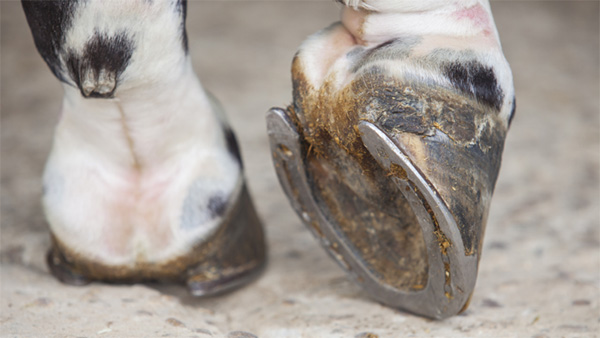No Hoof, No Horse: Laminitis Treatment and Prevention
It’s completely natural to assign human traits and emotions to our animals. After all, anthropomorphism is considered an innate tendency of human psychology. But what happens when this desire to humanize our four-legged friends goes too far? Take laminitis, for instance: a common cause of this highly painful, debilitating and potentially life-threatening disease is overfeeding — so could we actually be killing our horses with kindness?
Laminitis: What is it?
The literal definition of laminitis is inflammation of the laminae — the non-sensitive, outer epidermal tissue, as well as the sensitive, inner dermal tissue between the hoof wall and coffin bone — on a horse’s foot. These tissues mesh together to hold the hoof wall to the coffin bone (also known as the pedal bone). If the blood flow to these tissues is interrupted, inflammation can set in and weaken the laminae structures, thereby interfering with the connection between the hoof wall and coffin bone. This condition can affect just one foot or all four, but it most commonly affects the front feet at the same time and does not discriminate — it can impact any horse or pony.
Unless the cause of the inflammation is removed and treatment begins immediately at the first signs of laminitis, the dermal laminae will begin to die. Since they are responsible for significant support in the hoof, which bears the horse’s weight, the coffin bone may begin to sink and rotate due to the inability of the damaged laminae to support both the bone and the pull of the digital flexor tendon. The bone may even sink far enough to protrude from the sole of the foot. This is often irreversible but can occasionally be cured with a great deal of time and patience, along with a significant financial investment.
What causes it?
Several factors can play a role, but animals who are overweight or have previously suffered from laminitis are especially at risk. Common causes include:
- An excess intake of carbohydrates, either from overfeeding of grain, grain overload from a horse or pony getting into a feed room, or unrestricted access to lush pasture grasses
- The stress of a change in environment, frequent travel or foaling in broodmares
- Septicemic conditions, severe infections or retained placenta in mares post-foaling
- Obesity, particularly in ponies
- Lameness, which prevents the bearing of weight in one leg, leading to overloading of another limb
- Concussion to the hoof from working unshod on hard ground or from an overzealous hoof trim
- Metabolic disorders, such as Cushing’s disease
What are the signs?
The symptoms of acute laminitis are typically sudden and severe and include:
- Inability or reluctance to walk
- Lying down, combined with an unwillingness to stand
- Readily apparent lameness, especially when moving in a circle or walking on a hard surface
- Increased digital pulse
- Leaning back onto hind feet in an attempt to relieve the pressure on front feet
- Pain at the point of the frog and walking heel-first instead of toe-first
Chronic laminitis, also known as founder, can instead come on gradually and is often the result of either a sustained diet rich in carbohydrates or a metabolic disorder. It can also manifest in horses whose feet are severely compromised as the result of a previous, non-fatal, acute episode. Horses afflicted with chronic laminitis will typically exhibit the following symptoms:
- Lameness that ranges from mild to moderate
- A willingness to stand and walk, despite obvious foot pain
- Irregular bands of growth in the hoof wall
- Heels that grow faster than toes
- White line widening
- A noticeable crest running along the neckline
- Changed foot shape, often becoming narrow and elongated
Treatment
If you witness any of the above symptoms in your horse, contact both your veterinarian and farrier immediately. You will need to develop and administer a treatment plan as quickly as possible to prevent any lasting damage and to relieve any associated pain. When not treated quickly or correctly, permanent damage from laminitis can result in euthanasia.
- Horses who have been overfed must immediately be separated from their feed source; consult with your vet on a revised feeding regimen
- Move the horse or pony to a small pen or stall and bed deeply with shavings so they can dig their hooves into a comfortable position
- Avoid exercise, as it may initially contribute to further rotation of the coffin bone
- Have your farrier consult with your vet and trim the hoof according to the degree of rotation of the coffin bone
- Provide the horse with a companion to help minimize stress
Prevention
- Monitor your horse’s diet and weight very carefully
- Feed small amounts frequently to mimic a horse’s natural feeding patterns
- Restrict grass intake and avoid turning out on lush grasses, particularly in early spring or after heavy rains
- Maintain a consistent exercise regimen to aid in weight management
- Regularly schedule visits with a reputable farrier
This disease is very painful and incapacitating for horses. Remember that prevention is always better than a cure. As Albert Einstein said, “A clever person solves a problem. A wise person avoids it.”











